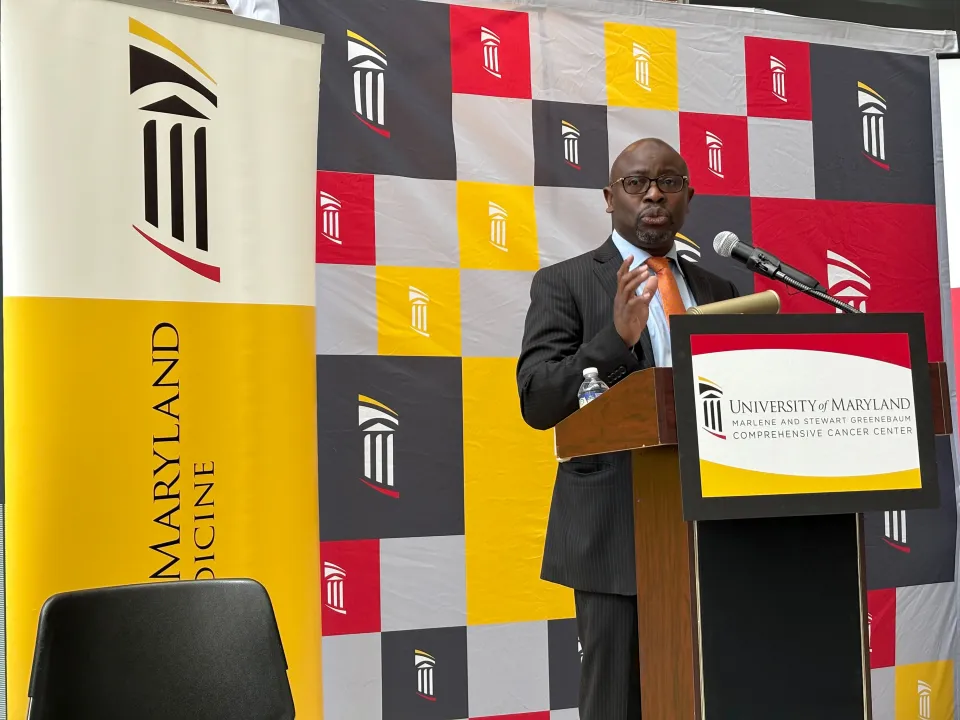New Public-Private Partnership to Improve Lung Cancer Screening Rates in MD

Dr. Taofeek Owonikoko, executive director of the UMGCCC, speaks at a press conference on Tuesday.
Published in the Baltimore Sun | April 19, 2024
Lung cancer is by far the leading cause of cancer deaths in America. Each year, it accounts for roughly 1 in 5 cancer deaths, killing more than colon, breast and prostate cancers combined.
However, only about 3% of those who are eligible to be screened for lung cancer actually get screened in Maryland — compared to roughly 83% of women eligible for screening statewide, who receive annual mammograms to be checked for breast cancer.
A new public-private partnership between the University of Maryland Marlene and Stewart Greenebaum Comprehensive Cancer Center (UMGCCC) and AstraZeneca seeks to change that.
The partnership, which University of Maryland Medical Center and AstraZeneca officials announced Tuesday afternoon at a news conference, will be propelled by up to $8 million in funding from the pharmaceutical giant over the next five years. Together, the institutions aim to improve community-based cancer screening and early detection in the state, which officials hope will lead to earlier diagnosis of the disease and more treatment options for patients.
“We know that when we find these diseases early, we can cure more patients and impact literally generations,” said Dr. Mohan Suntha, president and CEO of the University of Maryland Medical System, which also is involved in the partnership.
Additional partners include the University of Maryland Medical Center – where the Greenebaum Cancer Center is located – the University of Maryland School of Medicine and the University of Maryland, Baltimore.
In particular, doctors and researchers involved in the project hope to improve screening access to underserved communities in Maryland. While screening rates for lung cancer are universally low in the country, Black patients especially struggle to get checked for the disease. They’re 15% less likely to be diagnosed early than white patients and are 16% less likely to survive five years after their diagnosis, according to American Lung Association data.
“We believe health equity is really important and it starts in our own backyard,” said Mohit Manrao, senior vice president and head of U.S. oncology at AstraZeneca. “If we can’t move the needle on health equity here, coming together across the system, across academia, community and industry, then we cannot imagine the bigger impact that we want to have will be true.”
Under recommendations by the U.S. Prevention Services Task Force, adults between ages 50 and 80 who have a “20 pack-year” smoking history — meaning those who have smoked a pack a day for the last 20 years or two packs a day for the last 10 years — should be screened annually for lung cancer if they currently smoke or have quit within the past 15 years.
According to the Centers for Disease Control and Prevention, the only screening test for lung cancer that is currently recommended is a low-dose computed tomography, more commonly referred to as a low-dose CT scan. During this test, a patient lies on a table and an X-ray machine uses a low dose of radiation to take detailed pictures of their lungs.
In recent years, the rate of death and new cases from lung cancer have declined in America, as fewer people smoke and testing and treatment options improve. However, screening rates for lung cancer dropped dramatically during the pandemic and haven’t rebounded in the same way that screening rates for other kinds of cancer have recovered, said Dr. Mark Gladwin, dean of the University of Maryland School of Medicine.
“We have this opportunity now to bend that curve,” Gladwin said at the news conference, “and partner with our communities to do that.”
He added that he is hopeful another fledgling partnership — the University of Maryland Institute for Health Computing, co-led by the University of Maryland, College Park and the University of Maryland, Baltimore — will help the University of Maryland Medical System better identify patients who are at risk of developing lung cancer and who would benefit from screening.
While lung cancer is the second most common cancer among men and women, there’s a stigma around getting diagnosed with the illness, said Dr. Taofeek Owonikoko, the Greenebaum Cancer Center’s executive director. That stigma — which results from the stigma around smoking — likely contributes to the country’s low screening rates, he said.
Institutional barriers, like lack of access to a health care facility capable of providing low-dose CT scans, also present challenges to patients. And, Owonikoko said, the country has not “gotten behind” encouraging people to get tested for lung cancer in the same way it has gotten behind other health causes.
“I think in this type of partnership and effort, we are going to be able to identify champions within our own system, but also — most importantly — in the community,” Owonikoko said.
Doctors and researchers involved in the partnership envision developing a mobile low-dose CT scan program to improve access to early detection, the Greenebaum Cancer Center said in a news release.
They also hope to establish an outpatient clinic to provide follow-up care to people with suspicious CT scan results, study alternate forms of lung cancer screening, and expand educational and smoking cessation programs in communities throughout Maryland, according to the news release.
Officials at Tuesday’s news conference said they plan to expand the initiative to include breast, cervical and colon cancer screening within a few years.



